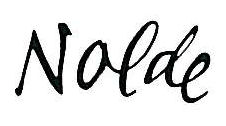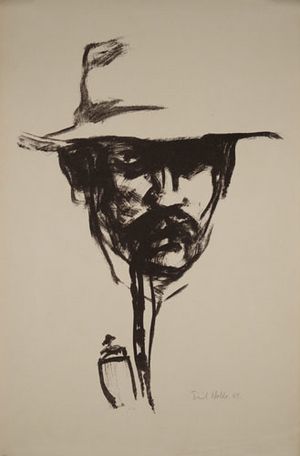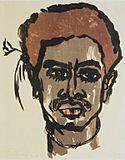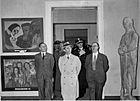Emil Nolde facts for kids
Quick facts for kids
Emil Nolde
|
|
|---|---|
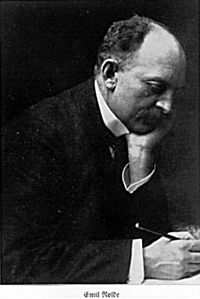
Nolde in 1929
|
|
| Born |
Hans Emil Hansen
7 August 1867 Nolde, Province of Schleswig-Holstein, Kingdom of Prussia, German Empire
|
| Died | 13 April 1956 (aged 88) Seebüll, Schleswig-Holstein, West Germany
|
| Nationality | German Danish |
| Known for | Painting, printmaking |
|
Notable work
|
Lesende junge Frau (1906) Blumengarten (ohne Figur) (1908) Blumengarten (Utenwarf) (1917) Blumen und Wolken (1933) |
| Movement | Expressionism |
Emil Nolde (born Hans Emil Hansen; August 7, 1867 – April 13, 1956) was a famous German-Danish painter and printmaker. He was one of the first artists to be part of a movement called Expressionism. Nolde was also one of the first painters in the early 1900s to really explore how colors could be used in oil and watercolor paintings.
He is well-known for his unique brushwork and how he chose colors. You can often see bright golden yellows and deep reds in his art. These colors make his paintings glow, even when the overall mood might be a bit serious. His watercolors often show vivid, stormy skies and beautiful, bright flowers. Nolde loved painting flowers, which showed his interest in the art of Vincent van Gogh.

Contents
Emil Nolde's Life Story
Emil Nolde was born Hans Emil Hansen near the village of Nolde. This area was part of Prussia at the time. He grew up on a farm with his parents, who were Danish and Frisian peasants.
Becoming an Artist
Nolde quickly realized that farm life was not for him. He felt very different from his three brothers. Between 1884 and 1891, he studied to become a woodcarver and illustrator in Flensburg. He also worked in furniture factories when he was young. He traveled to cities like Munich, Karlsruhe, and Berlin.
In 1889, he got into the School of Applied Arts in Karlsruhe. From 1892 to 1898, he taught drawing at a museum school in St. Gallen, Switzerland. Even though he was already 31, he decided to leave his job to follow his dream of becoming an independent artist. He had loved to paint and draw since he was a child.
When he was turned down by the Munich Academy of Fine Arts in 1898, he didn't give up. For the next three years, he took private painting lessons. He also visited Paris and learned about the popular Impressionist art style of that time.
Starting His Art Career
In 1902, he married Ada Vilstrup, a Danish actress. They moved to Berlin. There, he met art collector Gustav Schiefler and artist Karl Schmidt-Rottluff. Both of these people would later help share his artwork with the world. From that year on, he started calling himself Emil Nolde, after his birthplace.
In 1906, he was invited to join a new and exciting art group called Die Brücke (The Bridge) in Dresden. This group was known for its revolutionary Expressionist style. He was only with them for about a year.
Later, he was part of the Berlin Secession from 1908 to 1910. He left after a disagreement with the group's leaders. In 1912, he showed his art with another group called Der Blaue Reiter (The Blue Rider), led by Kandinsky. By this time, he was becoming quite famous and could make a living from his art.
Art During Difficult Times
Emil Nolde had some controversial political views. He believed that his style of art, Expressionism, was truly German. However, the Nazi government, led by Adolf Hitler, did not agree with him. Hitler called all modern art, including Nolde's, "degenerate art" (Entartete Kunst).
Even though Nolde had supported the Nazi Party, his art was officially banned. More than 1,000 of his artworks were taken from museums. Some of his paintings were even shown in the "Degenerate Art" exhibition in 1937, which was meant to make modern art look bad. Nolde protested this, but it didn't help. After 1941, he was not allowed to paint, even in private.
Despite the ban, Nolde secretly created hundreds of watercolors during this time. He called them his "Unpainted Pictures." He hid them away so no one would find them.
In 1942, Nolde wrote about colors:
There is silver blue, sky blue and thunder blue. Every color holds within it a soul, which makes me happy or repels me, and which acts as a stimulus. To a person who has no art in him, colors are colors, tones tones...and that is all. All their consequences for the human spirit, which range between heaven to hell, just go unnoticed.
After World War II, Nolde was honored again for his art. He received a special award called the Pour le Mérite. He passed away in Seebüll in 1956.
Nolde's Artworks
Besides paintings, Nolde created many prints, often in color. He also made many watercolor paintings of different things. These included landscapes, religious scenes, flowers, stormy seas, and scenes from Berlin nightlife.
One famous series of paintings came from his trip on the German New Guinea Expedition. During this journey, he visited places like the South Seas, Moscow, Siberia, Korea, Japan, and China.
His prints include many etchings, woodcuts, and lithographs.
Famous Artworks by Emil Nolde
Emil Nolde's art is displayed in major museums around the world. Some of his well-known works include:
- Portrait of a Young Woman and a Child
- Portrait of a Man (around 1926)
- Portrait of a Young Girl (1913–1914) – these are at the Hermitage Museum in Russia.
- Prophet (1921)
- Young Couple (1913) – these are at the Museum of Modern Art in New York City.
His print The Prophet (1912) is considered a very important artwork from the 20th century.
Some of his most important oil paintings are:
- Lesende junge Frau (Young Woman Reading) (1906)
- Blumengarten (ohne Figur) (Flower Garden (without figure)) (1908)
- Blumen und Wolken (Flowers and Clouds) (1933)
Art and History
One of Nolde's paintings, Blumengarten (Utenwarf) from 1917, is now at the Moderna Museet in Stockholm, Sweden. This painting was discovered to have been taken from Otto Nathan Deutsch, a German-Jewish refugee who had to flee Germany before World War II. His family, including a Holocaust survivor, asked for the painting to be returned. In 2007, the Swedish government decided that the museum should work with the family to resolve the issue.
Other important works by Nolde include:
- Lesende junge frau, 1906, oil on canvas, Kunsthalle Kiel
- Anna Wieds Garten, 1907, oil on canvas, Private Collection
- Steigende Wolken, 1927, oil on canvas, Karl-Ernst-Osthaus-Museum, Hagen
- Grosse Sonnenblumen, 1928, oil on canvas, The Metropolitan Museum of Art, New York
Nolde's paintings have sold for millions of dollars at international auctions. For example, Blumengarten (ohne Figur) was sold for over $3 million in 2012.
Images for kids
-
Nolde, South Sea Islander (Südsee-Insulaner II), 1915 lithograph in colors, on wove paper, Brooklyn Museum
See also
 In Spanish: Emil Nolde para niños
In Spanish: Emil Nolde para niños


